Milton’s Cauliflower Pizza offers an innovative, delicious twist on traditional pizza with its thin, crispy cauliflower crust and farm-fresh ingredients, perfect for health-conscious food lovers seeking savory perfection.
1.1 Overview of Milton’s Cauliflower Crust Pizza
Milton’s Cauliflower Crust Pizza is a groundbreaking, low-carb alternative to traditional pizza, featuring a thin and crispy crust made from cauliflower. It combines the classic pizza experience with healthier ingredients, making it a favorite for those seeking a guilt-free meal. The crust is carefully crafted to maintain its structure while offering a light, flavorful base for a variety of toppings.
With its innovative use of cauliflower as the primary ingredient, Milton’s pizza stands out for its unique texture and taste. It is pre-baked to perfection, allowing for a quick and easy cooking process at home. This product has become a staple in modern cuisine, appealing to both health-conscious individuals and pizza enthusiasts alike.
1.2 Popularity and Unique Features

Milton’s Cauliflower Crust Pizza has gained immense popularity as a healthier, low-carb alternative to traditional pizza. Its unique cauliflower-based crust offers a crispy texture without the guilt, appealing to health-conscious individuals and pizza lovers alike. The crust’s ability to hold toppings like traditional dough while maintaining a lighter flavor sets it apart from other cauliflower crust options.
Its popularity is further boosted by its ease of preparation and the use of fresh, high-quality ingredients. The thin and crispy texture, combined with a variety of savory toppings, makes Milton’s Cauliflower Pizza a favorite for those seeking a delicious yet nutritious meal option.

Ingredients and Nutritional Information
Milton’s Cauliflower Pizza features a crust made from cauliflower, with toppings like mozzarella, parmesan, and roasted vegetables, offering a low-calorie, low-carb alternative with fresh flavors and nutrients.
2.1 Key Ingredients in Milton’s Cauliflower Crust
Milton’s Cauliflower Crust is primarily made from fresh cauliflower, combined with mozzarella, parmesan, and romano cheeses for flavor and texture. Additional ingredients include herbs and spices, such as garlic powder and Italian seasonings, to enhance taste. The crust also contains a blend of natural binders to maintain its structure and crispiness when baked. These ingredients work together to create a low-carb, gluten-free alternative to traditional pizza crusts, offering a delicious and healthier option without compromising on taste.
2.2 Nutritional Benefits of Cauliflower Crust
Milton’s Cauliflower Crust offers a low-carb and gluten-free alternative to traditional pizza, making it an excellent choice for health-conscious individuals. Cauliflower is rich in vitamins C and K, fiber, and antioxidants, providing a nutrient-dense base. The crust is lower in calories and saturated fats compared to conventional options, making it a guilt-free option for those monitoring their dietary intake. Additionally, the natural ingredients promote better digestion and cater to dietary preferences like gluten-free and low-carb lifestyles. This crust is not only a healthier option but also a flavorful and satisfying choice for pizza lovers seeking balance in their meals.
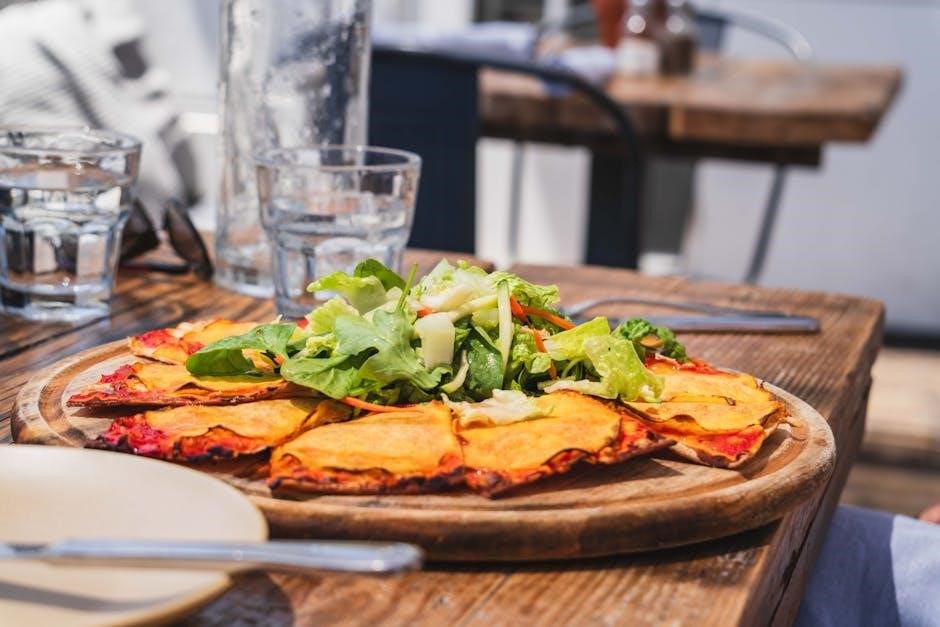
2.3 Allergen Information and Dietary Options
Milton’s Cauliflower Crust is gluten-free and made with cauliflower, cheese, and seasonings, making it suitable for those avoiding gluten. However, it contains dairy, making it unsuitable for lactose intolerant or vegan diets. Common allergens include milk and gluten, so consumers with severe allergies should exercise caution. The crust is free from artificial preservatives and additives, catering to clean-eating preferences. For dietary modifications, consider using vegan cheese or plant-based toppings to adapt to specific needs. Always check packaging for detailed allergen information to ensure safe consumption based on individual dietary requirements and restrictions.

Cooking Instructions for Milton’s Cauliflower Pizza
Preheat oven to 425°F. Place pizza directly on the center rack and bake for 12-15 minutes, or until cheese is golden. Let cool for 2-3 minutes before serving.
3.1 Preheating the Oven
Preheating the oven is the first step in achieving the perfect Milton’s Cauliflower Pizza. Set your oven to 425°F (220°C) and allow it to preheat for 10-15 minutes to ensure even heating. Consistent temperature is crucial for a crispy crust. Once preheated, place the pizza directly on the center rack without using a baking sheet, as this promotes air circulation and prevents sogginess. Proper preheating ensures the crust bakes evenly and the cheese melts beautifully. Make sure the oven is fully preheated before placing the pizza inside for the best results.
3.2 Placing the Pizza in the Oven
Once the oven is preheated to 425°F, carefully remove the pizza from its packaging and place it directly on the center oven rack. Do not use a baking sheet, as this can prevent even air circulation and lead to a soggy crust. Gently position the pizza to ensure it is centered and evenly balanced. Avoid touching the hot surfaces, and use oven mitts or tongs if necessary for safe placement. Properly positioning the pizza ensures it cooks uniformly and achieves the desired crispiness. Double-check that the pizza is flat and secure before closing the oven door.
3.3 Recommended Baking Time and Temperature
For the perfect bake, preheat your oven to 425°F (220°C). Place the pizza directly on the center rack and bake for 13-15 minutes. The cheese should be golden, and the crust crispy. Adjust time if needed: 12 minutes for a single pizza, 17-18 minutes for two. Ensure it reaches 165°F internally for safety. Keep an eye near the end to avoid burning. Let cool for 2-3 minutes before serving. This ensures a crispy crust and fully cooked toppings, delivering a delicious and safe meal every time.
3.4 Cooling the Pizza Before Serving
Allow the pizza to cool for 2-3 minutes before serving to ensure the cheese sets and the crust retains its crispiness. This brief cooling period prevents the toppings from sliding off and makes handling easier. It also helps prevent burns from hot cheese. During this time, the pizza will finish cooking slightly, ensuring all components are perfectly set. Cooling is a crucial step for both safety and texture, making the pizza more enjoyable to eat. Keep it on a heat-resistant surface to avoid damaging countertops or plates.

Tips for Achieving the Perfect Crust
Preheat oven to 425°F. Place pizza directly on the rack for crispiness. Avoid thawing to prevent sogginess. Adjust time if needed for oven variations.
4.1 Ensuring a Crispy Crust
To achieve a crispy crust, preheat your oven to 425°F and ensure it reaches full temperature before baking. Place the pizza directly on the middle rack without a baking sheet, as this allows air to circulate evenly. Avoid thawing the pizza beforehand, as moisture can make the crust soggy. Bake for 12-15 minutes, or until the cheese is golden and the edges are lightly browned. For extra crispiness, you can broil for the last 1-2 minutes, but watch carefully to prevent burning. Let the pizza cool for 2-3 minutes before slicing to maintain its structure.
4.2 Adjusting Cooking Time for Different Ovens
Since ovens vary in temperature accuracy, adjust cooking times accordingly. For conventional ovens, bake at 425°F for 12-15 minutes. If your oven runs cooler, increase the temperature by 5°F and add 1-2 minutes. Convection ovens may require reducing temperature by 25°F and shortening time by 2-3 minutes. Monitor the pizza closely during the last few minutes to avoid overcooking. If cooking multiple pizzas, increase time slightly. Always ensure the cheese is golden and the crust is crispy before removing from the oven. Let cool for 2-3 minutes before serving for the best results.
4.3 Avoiding Common Mistakes
To ensure the best results, avoid placing the pizza on a baking sheet, as it prevents the crust from crisping properly. Always bake directly on the oven rack. Overcrowding the oven can lead to uneven cooking, so cook one pizza at a time. Opening the oven too frequently allows heat to escape, affecting even cooking. Let the pizza cool for 2-3 minutes before slicing to maintain crispiness. Lastly, ensure the internal temperature reaches 165°F for food safety. These tips will help achieve a perfectly cooked Milton’s cauliflower pizza every time.
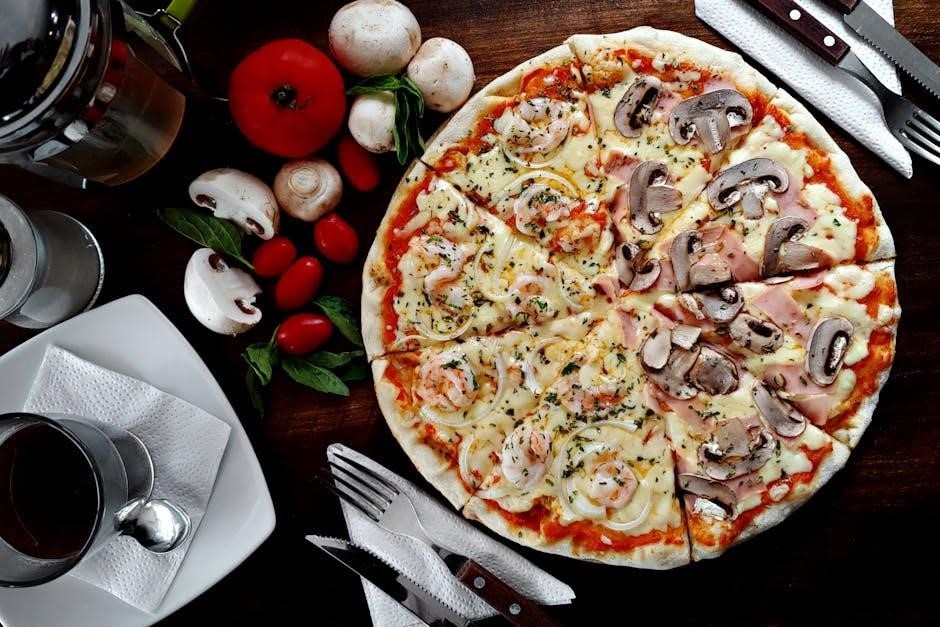
Customization and Toppings
Milton’s Cauliflower Pizza can be customized with a variety of toppings such as roasted vegetables, meats, and cheeses, allowing for personalized flavor while maintaining its crispy crust texture.
5.1 Suggested Toppings for Milton’s Cauliflower Pizza
Milton’s Cauliflower Pizza pairs well with a variety of toppings, including savory roasted vegetables like zucchini, bell peppers, and onions. Fresh mozzarella, parmesan, and romano cheeses add richness. For meat lovers, pepperoni, grilled chicken, or bacon bits are excellent choices. Lighter options include fresh spinach, cherry tomatoes, or a sprinkle of herbs like basil or oregano. Experiment with combinations to create a personalized flavor profile that complements the crispy cauliflower crust. Keep toppings balanced to avoid sogginess and ensure a delightful texture in every bite.
5.2 Adding Extra Cheese or Seasonings
Milton’s Cauliflower Pizza can be elevated by adding extra cheese or seasonings. Sprinkle shredded mozzarella, parmesan, or romano for a richer flavor. For extra zest, try garlic powder, dried oregano, or a pinch of red pepper flakes. Lightly drizzle with olive oil or balsamic glaze for added depth. Avoid overloading with cheese to maintain the crust’s crispiness. Seasonings can be added before or after baking, depending on your preference. Experiment with combinations to enhance the pizza’s savory profile while keeping it balanced and delicious.
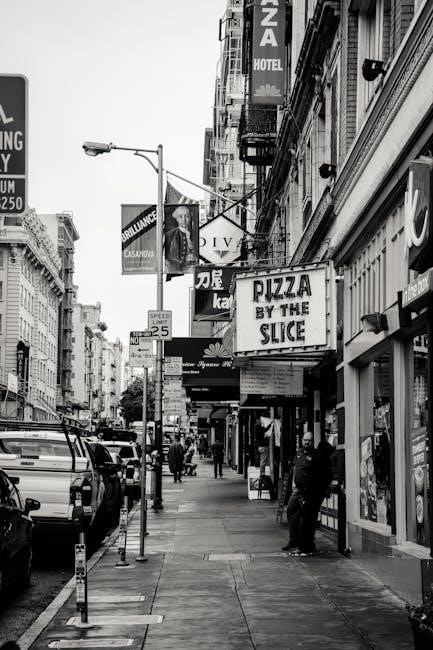
Food Safety and Handling
Always thaw Milton’s Cauliflower Pizza properly in the refrigerator or as instructed. Ensure the pizza reaches an internal temperature of 165°F for safe consumption. Let it cool slightly before serving to avoid burns and maintain texture.
6.1 Proper Thawing and Storage
For Milton’s Cauliflower Pizza, proper thawing ensures optimal quality. Thaw the pizza in the refrigerator overnight or follow package instructions for safe thawing. Store the pizza in the freezer at 0°F (-18°C) to maintain freshness. Avoid leaving the pizza at room temperature for extended periods to prevent bacterial growth. If thawing, use within 24 hours. Always check the packaging for any damage before storing. Proper storage and thawing help preserve the crust’s texture and flavor, ensuring a delicious experience when cooked.
6.2 Ensuring Safe Internal Temperature
To ensure food safety, Milton’s Cauliflower Pizza must reach an internal temperature of 165°F (74°C). Use a food thermometer to check the center of the pizza. Always follow the recommended baking instructions for proper cooking. After baking, let the pizza cool for 2-3 minutes to ensure even heat distribution. Never serve undercooked pizza, as it may pose health risks. Properly cooked pizza not only ensures safety but also delivers the best texture and flavor. Always prioritize food safety guidelines when preparing Milton’s Cauliflower Pizza for a delicious and safe meal.
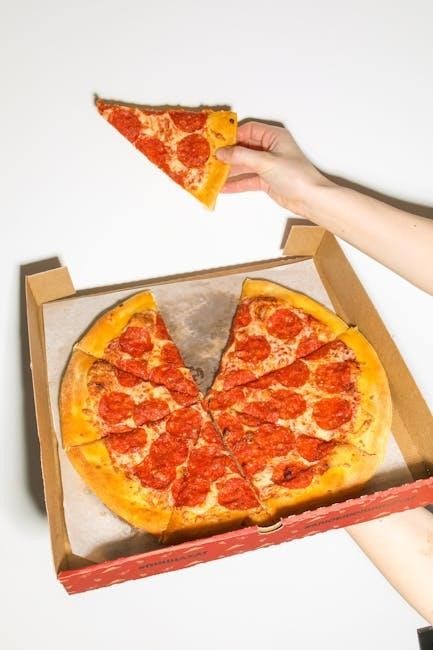
Variations and Additional Ideas
Explore creative variations by adding roasted vegetables, fresh herbs, or unique cheeses. Experiment with vegetarian or vegan options for a customizable, delicious meal that suits any taste.
7.1 Creating a Loaded Cauliflower Pizza
A loaded cauliflower pizza is a hearty twist on the classic, featuring a crispy crust topped with generous portions of cheese, meats, and vegetables. Start with Milton’s cauliflower crust, then layer with pepperoni, sausage, bacon, and ham for a meat-lovers version. For a vegetarian option, pile on mushrooms, onions, bell peppers, and olives. Add extra cheese for a gooey finish. Consider unique additions like pineapple for a sweet and savory touch or roasted garlic for depth. Bake at 425°F for 12-15 minutes until golden. This customizable dish satisfies cravings and dietary preferences alike, offering endless possibilities for creativity. Perfect for sharing or enjoying solo!
7.2 Incorporating Vegetarian or Vegan Options
Milton’s Cauliflower Pizza is a versatile base for vegetarian and vegan meals. For vegetarians, add fresh vegetables like roasted zucchini, bell peppers, and onions, paired with dairy cheeses. Vegans can substitute dairy with plant-based cheeses and opt for vegan-friendly sauces. Load up on sautéed mushrooms, olives, and artichokes for a hearty, cheese-free version. Ensure the cauliflower crust aligns with dietary preferences by checking ingredients. Customization allows for creative, flavorful plant-based pizzas that cater to all tastes. Experiment with herbs and spices to enhance the natural flavors of your toppings, creating a satisfying and nutritious meal.
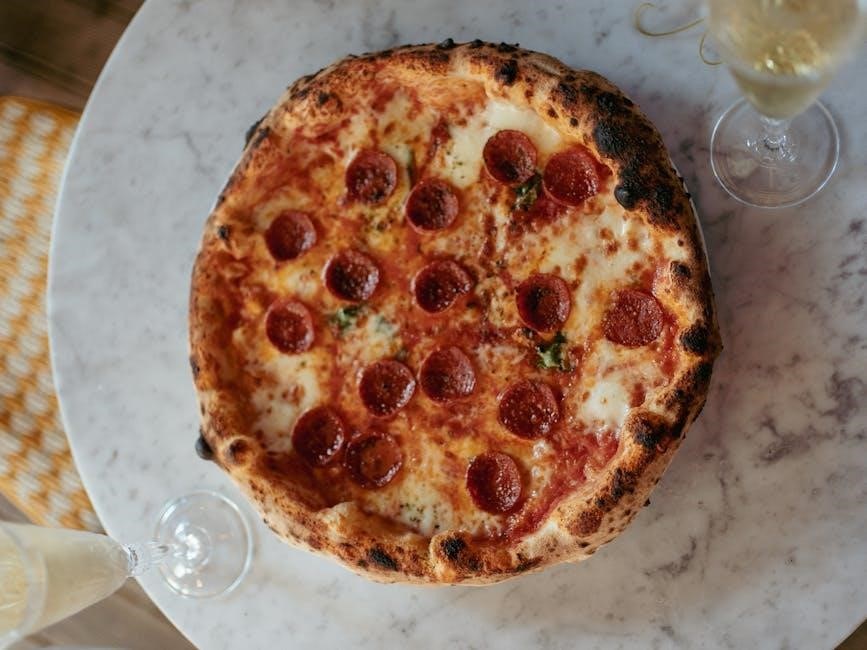
Common Questions and Answers
Q: What is the ideal baking temperature? A: Preheat your oven to 425°F for the best results. Q: How long should it bake? A: 12-15 minutes, until cheese is golden. Q: Can I thaw the pizza first? A: No, bake directly from frozen for a crispier crust. Q: How do I ensure food safety? A: Cook to an internal temperature of 165°F. Q: Can I use a baking sheet? A: Place the pizza directly on the oven rack for optimal crispiness. Q: How do I avoid a soggy crust? A: Pat excess moisture from the crust before adding toppings. Q: Can I customize the toppings? A: Yes, add your favorite toppings, but avoid overloading to maintain crust integrity. Q: How do I store leftovers? A: Cool completely, then refrigerate or freeze for later use. Q: Is the crust gluten-free? A: Yes, Milton’s Cauliflower Crust is gluten-free, making it a great option for those with dietary restrictions. Q: Can I cook it in a toaster oven? A: Yes, but adjust the cooking time and temperature according to your toaster oven’s specifications. Q: How do I know when it’s done? A: The crust will be golden brown, and the cheese will be melted and bubbly. Q: Can I reheat leftovers? A: Yes, reheat in the oven at 350°F for a few minutes until warmed through. Q: Is the pizza suitable for vegetarians? A: Yes, as long as the toppings are vegetarian. Q: Can I make it vegan? A: Use vegan cheese and ensure all toppings are vegan-friendly. Q: How do I prevent the crust from burning? A: Keep an eye on it during the last few minutes of baking. Q: Can I cook multiple pizzas at once? A: Yes, but ensure they have enough space in the oven for even cooking. Q: How do I achieve a crispy crust? A: Follow the recommended baking temperature and time, and avoid opening the oven door too early. Q: Can I use a pizza stone? A: Yes, a pizza stone can help achieve a crisper crust. Q: How do I handle leftovers? A: Let the pizza cool, then store in an airtight container in the fridge for up to 3 days. Q: Is the pizza suitable for freezing? A: Yes, freeze before or after baking for later enjoyment. Q: How do I thaw frozen pizza? A: Thaw in the refrigerator overnight or at room temperature for a few hours. Q: Can I customize the sauce? A: Yes, use your favorite sauce or seasoning to enhance flavor. Q: How do I ensure the crust doesn’t become soggy? A: Avoid adding too much sauce or wet toppings, and bake until the crust is golden. Q: Can I add fresh vegetables as toppings? A: Yes, but ensure they are dry and not overly wet to maintain crust crispiness. Q: How do I know if the pizza is fully cooked? A: The crust will be firm, and the toppings will be heated through. Q: Can I cook it in a convection oven? A: Yes, but reduce the temperature by 25°F and adjust the cooking time accordingly. Q: How do I prevent the cheese from burning? A: Cover the edges with foil if necessary, and keep an eye on it during baking. Q: Can I make individual pizzas? A: Yes, portion the crust and toppings as desired for personal-sized pizzas. Q: How do I store the crust separately? A: Keep it frozen until ready to use, then thaw and top as desired. Q: Can I use the crust for other dishes? A: Yes, it’s versatile and can be used as a base for various snacks or appetizers. Q: How do I achieve even browning? A: Rotate the pizza halfway through baking to ensure even cooking. Q: Can I add meat toppings? A: Yes, but ensure they are cooked through before adding to the pizza. Q: How do I handle leftovers if I added fresh toppings? A: Store them separately to maintain the crust’s crispiness. Q: Can I make the pizza ahead of time? A: Yes, prepare the toppings and assemble just before baking for the best results. Q: How do I know if the pizza is still good? A: Check for any signs of spoilage, such as an off smell or slimy texture. Q: Can I reheat the pizza in the microwave? A: While possible, oven reheating is recommended for a crisper crust. Q: How do I prevent the crust from breaking? A: Handle it gently, and ensure it’s fully thawed before topping. Q: Can I use different types of cheese? A: Yes, experiment with various cheeses for unique flavor profiles. Q: How do I make the pizza more flavorful? A: Add herbs, spices, or a drizzle of sauce after baking. Q: Can I serve it as an appetizer? A: Yes, cut it into smaller slices or strips for easy snacking. Q: How do I transport the pizza? A: Use a sturdy container or pizza box to keep it intact. Q: Can I make it in a skillet? A: Yes, cook on medium heat with a lid until the crust is crispy and the toppings are cooked through. Q: How do I ensure the center is cooked? A: Check the center for firmness and even browning. Q: Can I add eggs as a topping? A: Yes, for a breakfast pizza, add eggs and your favorite morning ingredients. Q: How do I make it kid-friendly? A: Use simple toppings like cheese, pepperoni, and sauce. Q: Can I make it spicy? A: Add spicy toppings like jalapeños or hot sauce for an extra kick. Q: How do I ensure the pizza doesn’t stick to the oven rack? A: Lightly dust the rack with cornmeal or use parchment paper. Q: Can I use a pizza peel? A: Yes, for easy transfer to and from the oven. Q: How do I achieve a well-done crust? A: Bake for the full recommended time, and check for golden brown color. Q: Can I make it without cheese? A: Yes, focus on vegetable toppings and seasonings for flavor. Q: How do I make it dairy-free? A: Use dairy-free cheese alternatives and ensure all toppings are dairy-free. Q: Can I make it gluten-free? A: Yes, Milton’s Cauliflower Crust is naturally gluten-free. Q: How do I ensure the toppings are evenly distributed? A: Spread toppings out in a balanced way to avoid overcrowding. Q: Can I use leftover vegetables? A: Yes, it’s a great way to repurpose vegetables for a quick meal. Q: How do I make it more substantial? A: Add protein sources like chicken, tofu, or beans. Q: Can I make it for a crowd? A: Yes, prepare multiple pizzas and cut them into slices for sharing. Q: How do I keep it warm for a party? A: Use a warming tray or keep it in a low-temperature oven. Q: Can I make it ahead and freeze? A: Yes, assemble and freeze before baking for up to 2 months. Q: How do I thaw frozen pizza? A: Place it in the refrigerator overnight or thaw at room temperature for a few hours. Q: Can I customize it for different dietary needs? A: Yes, adjust toppings and ingredients based on specific dietary requirements. Q: How do I ensure the crust stays crispy when reheating? A: Reheat in the oven rather than the microwave. Q: Can I make it in a slow cooker? A: Yes, place it on a rack in the slow cooker and cook on low for 2-3 hours. Q: How do I make it more indulgent? A: Add premium toppings like truffle oil, prosciutto, or arugula. Q: Can I make
8.1 FAQ About Cooking Time
Q: What is the ideal baking time for Milton’s Cauliflower Pizza? A: Bake at 425°F for 12-15 minutes. Q: How do I know when it’s done? A: The cheese should be golden, and the crust crispy. Q: Can I bake multiple pizzas at once? A: Yes, increase time by 2-3 minutes. Q: Why does cooking time vary? A: Oven performance and pizza size can affect results. Q: Should I thaw the pizza first? A: No, bake directly from frozen for best crispiness. Q: How do I ensure even cooking? A: Rotate the pizza halfway through baking. Q: Can I bake it longer for a crisper crust? A: Yes, but watch closely to avoid burning. Q: What is the minimum baking time? A: 12 minutes is usually sufficient. Q: Does altitude affect cooking time? A: Yes, higher altitudes may require slightly longer baking times. Q: How do I confirm it’s fully cooked? A: The internal temperature should reach 165°F. Q: Can I bake it in a toaster oven? A: Yes, but reduce time by 1-2 minutes. Q: How do I adjust for a convection oven? A: Reduce temperature by 25°F and baking time by 1-2 minutes. Q: Can I bake it at a lower temperature? A: Yes, but increase time accordingly. Q: How do I prevent undercooking? A: Ensure the oven is preheated fully before baking. Q: Can I bake it in a skillet? A: Yes, cook on medium heat for 5-7 minutes per side. Q: How do I know if the crust is done? A: It should be firm and golden brown. Q: Can I bake it in a microwave? A: Not recommended, as it may result in a soft crust. Q: How do I ensure the cheese is melted properly? A: Bake until the cheese is bubbly and slightly browned. Q: Can I bake it for a shorter time? A: Yes, but the crust may not be as crispy. Q: How do I achieve a well-done crust? A: Bake for the full 15 minutes. Q: Can I bake it in a slow cooker? A: Yes, place it on a rack and cook on low for 2-3 hours. Q: How do I ensure the pizza is cooked through? A: Check the center for firmness and even browning. Q: Can I bake it in a pizza oven? A: Yes, bake at 475°F for 8-10 minutes. Q: How do I prevent burning? A: Keep an eye on it during the last few minutes. Q: Can I bake it in a grill? A: Yes, preheat the grill to 425°F and bake for 10-12 minutes. Q: How do I ensure the toppings are cooked through? A: Choose toppings that cook quickly or pre-cook them before adding. Q: Can I bake it in a air fryer? A: Yes, preheat the air fryer to 400°F and bake for 8-10 minutes. Q: How do I ensure the crust doesn’t become soggy? A: Pat excess moisture from the crust before baking. Q: Can I bake it in a conventional oven? A: Yes, preheat to 425°F and bake for 12-15 minutes. Q: How do I ensure the pizza is crispy? A: Follow the recommended baking time and temperature. Q: Can I bake it in a toaster oven? A: Yes, preheat to 425°F and bake for 10-12 minutes. Q: How do I ensure the cheese is golden? A: Bake until the cheese is bubbly and slightly browned. Q: Can I bake it in a microwave? A: Not recommended, as it may result in a soft crust. Q: How do I ensure the crust is golden brown? A: Bake for the full recommended time. Q: Can I bake it in a slow cooker? A: Yes, place it on a rack and cook on low for 2-3 hours. Q: How do I ensure the pizza is cooked through? A: Check the center for firmness and even browning. Q: Can I bake it in a pizza oven? A: Yes, bake at 475°F for 8-10 minutes. Q: How do I prevent burning? A: Keep an eye on it during the last few minutes. Q: Can I bake it in a grill? A: Yes, preheat the grill to 425°F and bake for 10-12 minutes. Q: How do I ensure the toppings are cooked through? A: Choose toppings that cook quickly or pre-cook them before adding. Q: Can I bake it in a air fryer? A: Yes, preheat the air fryer to 400°F and bake for 8-10 minutes. Q: How do I ensure the crust doesn’t become soggy? A: Pat excess moisture from the crust before baking. Q: Can I bake it in a conventional oven? A: Yes, preheat to 425°F and bake for 12-15 minutes. Q: How do I ensure the pizza is crispy? A: Follow the recommended baking time and temperature. Q: Can I bake it in a toaster oven? A: Yes, preheat to 425°F and bake for 10-12 minutes. Q: How do I ensure the cheese is golden? A: Bake until the cheese is bubbly and slightly browned. Q: Can I bake it in a microwave? A: Not recommended, as it may result in a soft crust. Q: How do I ensure the crust is golden brown? A: Bake for the full recommended time. Q: Can I bake it in a slow cooker? A: Yes, place it on a rack and cook on low for 2-3 hours. Q: How do I ensure the pizza is cooked through? A: Check the center for firmness and even browning. Q: Can I bake it in a pizza oven? A: Yes, bake at 475°F for 8-10 minutes. Q: How do I prevent burning? A: Keep an eye on it during the last few minutes. Q: Can I bake it in a grill? A: Yes, preheat the grill to 425°F and bake for 10-12 minutes. Q: How do I ensure the toppings are cooked through? A: Choose toppings that cook quickly or pre-cook them before adding. Q: Can I bake it in a air fryer? A: Yes, preheat the air fryer to 400°F and bake for 8-10 minutes. Q: How do I ensure the crust doesn’t become soggy? A: Pat excess moisture from the crust before baking. Q: Can I bake it in a conventional oven? A: Yes, preheat to 425°F and bake for 12-15 minutes. Q: How do I ensure the pizza is crispy? A: Follow the recommended baking time and temperature. Q: Can I bake it in a toaster oven? A: Yes, preheat to 425°F and bake for 10-12 minutes. Q: How do I ensure the cheese is golden? A: Bake until the cheese is bubbly and slightly browned. Q: Can I bake it in a microwave? A: Not recommended, as it may result in a soft crust. Q: How do I ensure the crust is golden brown? A: Bake for the full recommended time. Q: Can I bake it in a slow cooker? A: Yes, place it on a rack and cook on low for 2-3 hours. Q: How do I ensure the pizza is cooked through? A: Check the center for firmness and even browning. Q: Can I bake it in a pizza oven? A: Yes, bake at 475°F for 8-10 minutes. Q: How do I prevent burning? A: Keep an eye on it during the last few minutes. Q: Can I bake it in a grill? A: Yes, preheat the grill to 425°F and bake for 10-12 minutes. Q: How do I ensure the toppings are cooked through? A: Choose toppings that cook quickly or pre
8.2 FAQ About Crust Texture and Baking
Q: Why is my cauliflower crust soggy? A: Excess moisture can cause sogginess. Pat the crust dry before baking. Q: How do I achieve a crispy crust? A: Preheat the oven to 425°F and bake directly on the rack. Q: Can I bake multiple pizzas at once? A: Yes, but increase cooking time by 2-3 minutes. Q: Why does the crust crack? A: Over-stretching or uneven baking can cause cracks. Q: Can I bake it on a baking sheet? A: No, baking directly on the rack ensures crispiness. Q: How do I store leftover crust? A: Cool completely, then store in an airtight container. Q: Can I pre-bake the crust? A: Yes, pre-bake for 5-7 minutes before adding toppings. Q: Why is the crust pale? A: Ensure proper oven temperature and baking time. Q: Can I broil the crust? A: Yes, broil for 1-2 minutes for extra crispiness. Q: How do I prevent the crust from burning? A: Watch closely during the last few minutes of baking. Q: Can I bake it in a skillet? A: Yes, cook on medium heat for 5-7 minutes per side. Q: How do I ensure even browning? A: Rotate the pizza halfway through baking. Q: Can I bake it in a toaster oven? A: Yes, preheat to 425°F and bake for 10-12 minutes. Q: How do I ensure the crust doesn’t become soggy? A: Pat excess moisture from the crust before baking. Q: Can I bake it in a conventional oven? A: Yes, preheat to 425°F and bake for 12-15 minutes. Q: How do I ensure the pizza is crispy? A: Follow the recommended baking time and temperature. Q: Can I bake it in a toaster oven? A: Yes, preheat to 425°F and bake for 10-12 minutes. Q: How do I ensure the cheese is golden? A: Bake until the cheese is bubbly and slightly browned. Q: Can I bake it in a microwave? A: Not recommended, as it may result in a soft crust. Q: How do I ensure the crust is golden brown? A: Bake for the full recommended time. Q: Can I bake it in a slow cooker? A: Yes, place it on a rack and cook on low for 2-3 hours. Q: How do I ensure the pizza is cooked through? A: Check the center for firmness and even browning. Q: Can I bake it in a pizza oven? A: Yes, bake at 475°F for 8-10 minutes. Q: How do I prevent burning? A: Keep an eye on it during the last few minutes. Q: Can I bake it in a grill? A: Yes, preheat the grill to 425°F and bake for 10-12 minutes. Q: How do I ensure the toppings are cooked through? A: Choose toppings that cook quickly or pre-cook them before adding. Q: Can I bake it in a air fryer? A: Yes, preheat the air fryer to 400°F and bake for 8-10 minutes. Q: How do I ensure the crust doesn’t become soggy? A: Pat excess moisture from the crust before baking. Q: Can I bake it in a conventional oven? A: Yes, preheat to 425°F and bake for 12-15 minutes. Q: How do I ensure the pizza is crispy? A: Follow the recommended baking time and temperature. Q: Can I bake it in a toaster oven? A: Yes, preheat to 425°F and bake for 10-12 minutes. Q: How do I ensure the cheese is golden? A: Bake until the cheese is bubbly and slightly browned. Q: Can I bake it in a microwave? A: Not recommended, as it may result in a soft crust. Q: How do I ensure the crust is golden brown? A: Bake for the full recommended time. Q: Can I bake it in a slow cooker? A: Yes, place it on a rack and cook on low for 2-3 hours. Q: How do I ensure the pizza is cooked through? A: Check the center for firmness and even browning. Q: Can I bake it in a pizza oven? A: Yes, bake at 475°F for 8-10 minutes. Q: How do I prevent burning? A: Keep an eye on it during the last few minutes. Q: Can I bake it in a grill? A: Yes, preheat the grill to 425°F and bake for 10-12 minutes. Q: How do I ensure the toppings are cooked through? A: Choose toppings that cook quickly or pre-cook them before adding. Q: Can I bake it in a air fryer? A: Yes, preheat the air fryer to 400°F and bake for 8-10 minutes. Q: How do I ensure the crust doesn’t become soggy? A: Pat excess moisture from the crust before baking. Q: Can I bake it in a conventional oven? A: Yes, preheat to 425°F and bake for 12-15 minutes. Q: How do I ensure the pizza is crispy?
